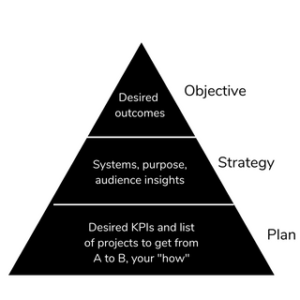Creating a Marketing Plan for your SaaS

First, let’s define the difference between a marketing strategy and marketing plan.
For your best shot at success creating a strategy, we’ve gotta do what every strategist does before defining anything: data-gathering. We’re going to need information first and to take stock of what’s going on so we can better understand where we’d like to go.
In the SaaS-world, that usually means we start with customer research, market research, and good old fashioned KPI reviews.
Once your strategy has been set, then you can create a marketing plan (we’ll cover how to do this today).
Your marketing plan is a list of campaigns and programs with a set budget and timeline that caters to your overall strategy. Here’s how to create an effective marketing plan step-by-step:
How to Create an Effective SaaS Marketing Plan
Choose specific target markets or segments you want to acquire or grow
Marketing plans are specific and detail-oriented. They’re a zoomed in slice working toward your overall marketing goals.
For this particular marketing plan (let’s say over the next 6 months), what target markets or segments would you like to acquire or grow?
Your pre-determined marketing strategy will come in handy for this. What sector of your target audiences would you like to zoom in on and target?
Identify the lifecycle stage to acquire or grow
Acquisition, Activation, or Retention
Now that you’ve identified your target market or segment, you then want to think about which lifecycle stage they’re in:
- Acquisition: acquiring new leads or potential customers
- Activation: converting leads to paying customers
- Retention: retaining paying customers and for how long
Select marketing channels based on LTV (eventually CAC)
To start, let’s set some definitions:
LTV stands for lifetime value and tells you how much a customer has spent with you over the course of their entire time as a customer.
CAC stands for customer acquisition cost and tells you how much your company spent to acquire a given customer. Your CAC will differ depending on the marketing channel.
Now that you’ve selected your target market and the lifecycle stage you want to focus on, you can then look at past data for LTV and CAC to determine which marketing channels you’d like to focus on throughout this marketing plan.
Ideally you want to select marketing channels that give you the highest LTV and the lowest CAC. Use past data (if you have it) to determine the best channels to focus on.
Design campaigns and programs
Campaigns are one-off events such as a feature launch or a conference that’s coming up, whereas programs are ongoing efforts like content marketing that need to be set up, but then continue running forever.
Your marketing plan will likely consist of both campaigns and programs that you’d like to launch. Based on the channels you’ve selected above (using LTV and CAC if available to you), you can start creating a list of campaigns and programs to create and foster over the next 6 months.
You don't want to miss the next one.
Every week or so, I'll drop a growth marketing knowledge bomb right here on this blog, and I've got a feeling if you're here, you won't want to miss it. I'll only send you actionable, relevant advice on marketing and growth for early-stage startups. Whether you're funded or bootstrapped, B2B or B2C, there's absolutely something to be learned, gained, and leveraged. Subscribe below.
Align your plan to key success KPIs
Now is a good time to pause and look at the campaigns/programs you’ve selected. Do they align with the key success KPIs in your overall marketing strategy?
We’d be remiss if we also didn’t briefly cover examples of leading versus lagging indicators and how they impact behaviors.
Leading indicators alert you as to whether you will reach your desired KPI goals. For example, if you desire to grow organic traffic, then a leading indicator would be blog posts published per month. In other words, if you’re not publishing the blog posts, you have a pretty good idea that you will not hit your goal. Other common leading indicators might include campaigns run per quarter or MQLs generated.
Lagging indicators measure the results or outcomes, such as measuring traffic, leads, trials, or demos.
As you move forward, use your core KPIs as a north star guiding you where you want to go. Consider your leading and lagging indicators for each campaign and program you’re running and how you’ll get in front of any issues that might present.
Prioritize your campaign and program list
To prioritize what needs to get done, look at your key KPIs and core objectives:
- Which action steps will likely yield the best results (towards your desired goal) given what you know about your customers, the market, and past results?
- Which action steps follow the natural order of operations? For example, you want to improve your website’s conversion rate before generating loads of traffic.
- Which actions are most likely to get completed? Use your best judgment to gauge what is achievable.
If you’re still having a hard time prioritizing, we recommend these frameworks:
Frameworks for prioritization
We like to use the ICE and PIE frameworks here at DemandMaven:
#1 ICE
- Impact: the amount we believe we can improve the target metric (scale of 1-5)
- Confidence: the percentage of confidence we have in the project (0-99%)
- Effort: the number of weeks of time it will take to execute
You then take those numbers and calculate a value score:
Using each project’s value score, prioritize them from most valuable to least valuable.
#2 PIE
- Potential: on a scale from 1-10, what is the potential for this task? (10 is high potential)
- Importance: on a scale from 1-10, how important is this task? (10 is important)
- Ease: on a scale from 1-10, how easy is this task? (10 is very easy)
Take the average of those three numbers for your final value score. Then, prioritize your projects by their PIE score.
You can also chat with a strategist whether on your team or outsourcing.
Get our thoughts by reaching out here 👋
Get realistic about your plan’s timeline
As you create your plan timeline, keep the following in mind:
- How long will each task take to complete? Create realistic expectations!
- How long will each task take to produce results?
- Does each part of the plan have a specific start and end date?
- Are there any deadlines or seasonality to keep in mind?
Creating a timeline will help you measure success or failure accordingly, especially as you start regularly checking in on the progress of your plan (more on this below).
Determine your plan’s budget
Keep in mind your marketing plan’s budget is different from your overall marketing budget.
When you’re creating a marketing plan, you’re taking a slice of your overall marketing budget and assigning it towards a specific plan.
The beauty of having a plan is that you now have an itemized list of everything that needs to get done and ideally by when. Go item-by-item in your action list and assign a dollar amount for each activity. Your plan’s budget should prioritize the activities that will likely yield the best return on investment (ROI).
Select your team
Who is helping you accomplish this plan? Decide the team, inform them, and then start delegating. We’ve noticed founders frequently forget this step or leave it unclear, yet it’s so important.
Get to work
Phew! You’ve done a lot of heavy-lifting until this point. You have a clear goal, strategy, KPIs, action items, timeline, team, and already solved key success gaps before you even started. Now it’s time to actually execute the plan, roll up your sleeves, and get to work.
Schedule regular check-ins and continue accordingly
A common pitfall we see with marketing plans is that they’re brilliantly created and then never executed. Or, they’re executed but never measured for success or failure. For best results, schedule check-ins within your project timeline. If your marketing plan is six-months long, aim to check-in once every month or every two months.
#1 Check in with your marketing plan
Are you moving at the pace you planned to? Are you on track? Any adjustments needed in terms of execution, team, or budget?
#2 Check in with your metrics
Are your strategic hunches paying off? Are you improving your desired KPIs? Any unforeseen consequences you didn’t see coming? Any adjustments needed?
#3 Make changes or simply keep going
Based on what you just uncovered, identify if any changes need to be made so you most effectively move towards your core objective and positively impact your key KPIs.
When you’ve completed your plan, take inventory, update your strategy, and create a new plan
Remember when we said your marketing plan should have a clear start and end date? Well, eventually you’ll hit your end date. At that point, it’s time to take stock of your results, update your strategy as needed, and create a new plan.
You likely need to create a new marketing plan every quarter, six months or year depending on the nature of your marketing plans.
Next Steps
Not sure if you have the right strategy in place before you create your marketing plan? Check out these posts for assistance:
- Overwhelmed by too many marketing channels, tactics, and experiments to run? Do this instead
- What even is “strategy” anyway?
- How to prioritize your growth ideas
And if you’re looking to hire strategic help, we offer a GTM engagement for those who have hit $10k MRR and our Growth engagement for those who have hit $1M ARR and want to kick it up a notch. These engagements include:
- In-depth customer research
- A strategy plan you’ll want to drool over
Book a call with me to learn more ✨


